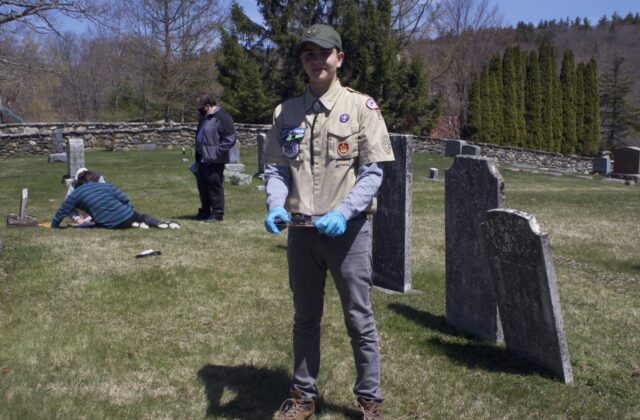Scout Project Honors Norfolk Veterans
By Wiley Wood
On a recent Saturday morning, a group gathered around a headstone lying face down on the sod of the Grantville Cemetery in Norfolk. Some carried clipboards, others flashlights, brushes and putty knives; one carried a bulging ring binder. All were wearing masks. They were part of a task force assembled by John Moran, 15, of Boy Scout Troop 22 in Canaan, to identify the graves of all the veterans in Norfolk’s town cemeteries and provide them with flag holders.
Moran started working last year with Daryl Byrne, Norfolk’s veterans’ affairs liaison, on the process of updating and digitizing the town’s veterans’ data. “Our records are pretty good up to the 1990 conflict of the Persian Gulf War,” says Byrne, “but beyond that we don’t have any confirmation of who actually served.” When Moran approached him about ideas for an Eagle Scout project, Byrne says, “I realized that, although people go out and place flags on the graves of the veterans they’re aware of, we don’t actually know where all the veterans are in the town cemeteries.” This became the basis of Moran’s project.
“It’s a huge task,” says Town Historian Richard Byrne, who, as sexton of the eight-acre Center Cemetery on Old Colony Road, spent six years collecting information on its graves.
The core group of volunteers consists of other members of Troop 22, who come from Norfolk and the surrounding towns. Over the past month, Moran has gathered them for a morning’s work in each of the town’s three municipal cemeteries—South Norfolk, Benedict Pond and Grantville. Norfolk has nine cemeteries all told, but the other six are private.
Divided into smaller work groups, the volunteers have fanned out this morning across Grantville Cemetery to read the name on each headstone, record its location on a cemetery map and crosscheck it against town hall’s list of veterans.
Richard Byrne explains the basic organization of the site: “You’ll see a square stone marker at each corner of a family’s plot with the initial of the family’s name on it. And often you’ll see an aluminum marker next to it, so it can be found with a metal detector.” The taller stones are headstones, and the shorter ones, particularly in the older sections of the cemetery, are footstones. Sometimes an obelisk at the center of a family plot will gather the names of all the surrounding family graves.
Moran and his younger brother Daniel, at the center of the group gathered around the fallen headstone, carefully tip the stone up on one of its longer edges. A woman’s name is clearly legible, along with her 19th-century dates. The contact with the soil has preserved the soft sandstone surprisingly well from the erosion of wind and weather. The name is duly noted on the map.
“It’s one of the benefits to the town,” said Richard Byrne, “that in addition to locating the veterans’ graves, the group is assigning all the other graves on the map a name.”
In his ring binder, Byrne carries a typescript made by Sarah Burr, a town clerk in the 1930s, of all the inscriptions on the Grantville Cemetery stones. But because the entries are ordered alphabetically, irrespective of their position in the graveyard, and because the carvings have lost legibility in the intervening 90 years, it is often difficult to match the faint hollows on the headstones with the inscriptions in Byrne’s typescript.
The flashlight, shined with a raking light across the stone’s surface, particularly after some of the lichen has been removed with a soft brush, helps highlight the shallow letters on the worn rock.
“I see the word “captain,” says one of the volunteers.
“Is it a Captain Grant, died 1817, age 75?” asks Byrne. When further examination confirms this, the information is recorded. “He must have served in the Revolutionary War,” Byrne muses.
At the end of the morning, John Moran thanks his helpers. Among the day’s findings are two captains, not previously recorded as such in the town’s records, and a survivor of the attack on Pearl Harbor. The morning’s outing leaves each of the participants with an expanded sense of the lives that have preceded ours.

